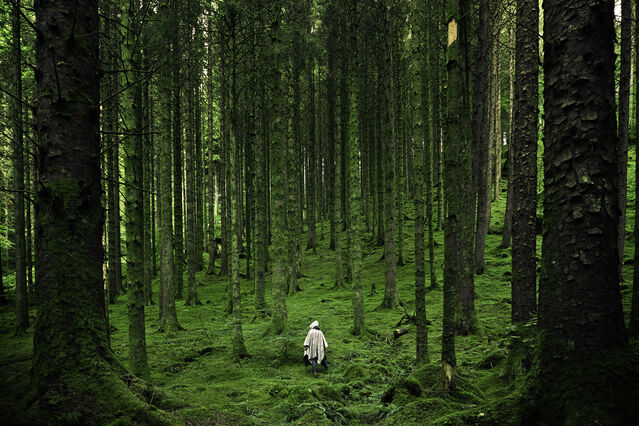Environment
Fed Up with Tech Fatigue? Look to Nature
Research shows nature can improve mood, reduce stress, restore creative energy.
Posted October 26, 2020

Look Beyond the Screen
The Greek philosopher Epictetus is credited with saying, “You become what you give your attention to.” Founder of American psychology William James with the statement, “My experience is what I agree to tend to.”
At first glance, these maxims seem straightforward enough. If you practice self-care and cultivate your creative ideas, then you will be that much closer to living the life you aspire to. But if you water the weeds that inevitably infiltrate the garden of your mind – your anxieties and fears – those will grow as well.
Like so many of us, you’ve probably been watering those weeds a lot more than usual this past year. Between vehement political divides, social upheaval, natural disasters, and a global pandemic, it’s been difficult not to feed our fears. However, our digital solution to this chronic stress and uncertainty only serves to further undermine our well being.
With the economic shutdowns and shelter in place mandates, we’ve become even more compulsively reliant on our devices for self-soothing and social connection. According to a recent survey by One Poll, Americans are spending up to 19 hours per day immersed in our technology. At that rate, the average American would spend 44 years of their life glued to a screen!
If you’ve succumbed to this widespread digital malaise these past months, you are not entirely to blame. We live in a “distraction economy,” a world wired by tech corporations that misuse the psychology of attraction to get you, unconsciously, to hang out on their platforms for longer and longer. Though scrolling through Facebook or binging Netflix seems innocent enough, so much screen time can actually increase our “technostress,” negatively impacting both our mental health and our physical well-being.
It can be difficult to consciously direct our attention to more uplifting or fruitful pastimes when there are so many crises and digital temptations vying for our attention. We can, however, learn to redirect our gaze. Rather than succumbing to virtual temptations, research suggests that we look to nature.
Two Types of Attention
The sounds of rustling leaves, the warmth of the sun on your skin, the scent of a pine forest, or a sea breeze: just thinking about these things can be comforting to us. But why? What exactly is happening in the brain?
Psychological research identifies two types of attention: directed attention and involuntary attention. As the name implies, the former describes when we consciously focus our attention on the task at hand. But when we try to focus on something for too long – whether we’re advancing a work project or scrolling through status updates – we can fall prey to “direct attention fatigue,” making us more impulsive, irritable, and distractible as our devices further deplete our energy, empathy, and creativity.
Involuntary attention, on the other hand, arises when we are immersed in a setting that sparks awe and piques our fascination. Natural environments invoke this kind of automatic attention better than most any man-made setting, giving our busy brains a much-needed break from our tech-fueled lives.
Look to the Present and to the Future – in Nature
Numerous studies have shown that being in nature – even observing natural scenery or nature photos – can improve mood, boost memory, restore our ability to focus, and replenish our creative energy.
But beyond these mental and emotional benefits, nature can actually improve our physical health, and not just through exercise. Being in or observing nature activates the parasympathetic nervous system which helps to reduce stress. Lowering stress levels creates a domino effect that can impact the entire body by boosting the immune system and reducing inflammation. One study even found that participants who spent time in nature saw a decrease in heart rate, blood pressure, and in the production of stress hormones as compared to participants in urban environments.
These findings have far-reaching implications for city planners, workplaces, organizations, and institutions because they reveal the psychological and physiological impacts of the spaces we inhabit. For example, research on restorative environments has found that patients heal faster, have fewer complications, and require less pain medication if they have a view of some greenery through their hospital room window. Similarly, children who live in greener environments are better able to sustain focused attention, delay gratification, and inhibit impulses.
If we can factor the benefits of natural scenery and design for experiences of wonder and delight, perhaps we can build for a healthier, more vibrant future.
Don’t Run, Bathe
If you live in a city – as 66 percent of the world’s population is expected to by 2050 – fret not. You don’t have to create your own Walden or escape to experience the benefits of nature.
A glimpse of trees out the window, a walk around the neighborhood on your lunch break, or simply decorating your workspace with some natural imagery can restore your energy and inspiration. In fact, research has shown that workers with a view of greenery report greater job satisfaction and better health, while one study found that decorating an office with potted plants could increase productivity by as much as 15 percent.
However you access nature in your day-to-day life, it’s important to remember that it’s not all about exercise or some quest to conquer the wild – as it’s portrayed far too often in American culture. To fully experience the therapeutic benefits that nature has to offer, think of it more like a bath.
The ancient Japanese practice of “forest bathing,” or shinrin yoku, is meant to be as idle and relaxing as the name suggests. It involves slowly walking through the woods – though any natural setting will do – and experiencing the natural environment with all of your senses.
Next time you find yourself overwhelmed by anxiety, irritability, or exhaustion try to find a quiet place with a bit of greenery, or imagine yourself in your favorite natural setting. Pause and try to observe the sights, sounds, scents, and feelings that the space evokes. Pay attention to the profusion of life that abounds in even the most domesticated park or patch of grass. Hopefully, your worries can melt away for a minute or two as you put your anxieties in perspective and connect more deeply with the world around you.
In the words of Robert Breault, American operatic tenor: “I sit in my garden, gazing upon a beauty that cannot gaze upon itself. And I find sufficient purpose for my day.”
References
Atchley, R., Strayer, D., & Atchley, P. (2012, December 12). Creativity in the Wild: Improving Creative Reasoning through Immersion in Natural Settings. Retrieved October 20, 2020, from https://journals.plos.org/plosone/article?id=10.1371%2Fjournal.pone.005…
Berman, M., Kross, E., Krpan, K., Askren, M., Burson, A., Deldin, P., . . . Jonides, J. (2012, November). Interacting with nature improves cognition and affect for individuals with depression. Retrieved October 20, 2020, from https://www.ncbi.nlm.nih.gov/pmc/articles/PMC3393816/
Fischer, T., & Riedl, R. (1970, January 01). [PDF] Theorizing Technostress in Organizations: A Cybernetic Approach: Semantic Scholar. Retrieved October 20, 2020, from https://www.semanticscholar.org/paper/Theorizing-Technostress-in-Organi…
Hartig, T., Mang, M., & Evans, G. W. (1991, January 1). Restorative Effects of Natural Environment Experiences. Retrieved October 19, 2020, from https://doi.org/10.1177/0013916591231001
J;, B. (2010, May 15). What is the best dose of nature and green exercise for improving mental health? A multi-study analysis. Retrieved October 20, 2020, from https://pubmed.ncbi.nlm.nih.gov/20337470/
Jo, H., Song, C., & Miyazaki, Y. (2019, November 27). Physiological Benefits of Viewing Nature: A Systematic Review of Indoor Experiments. Retrieved October 20, 2020, from https://www.ncbi.nlm.nih.gov/pmc/articles/PMC6926748/
Li, Q. (2010, January). Effect of forest bathing trips on human immune function. Retrieved October 20, 2020, from https://www.ncbi.nlm.nih.gov/pmc/articles/PMC2793341/
Mao, G. X., Lan, X. G., Cao, Y. B., Chen, Z. M., He, Z. H., Lv, Y. D., . . . Yan, J. (2012, June 25). Effects of short-term forest bathing on human health in a broad-leaved evergreen forest in Zhejiang Province, China. Retrieved October 20, 2020, from https://pubmed.ncbi.nlm.nih.gov/22840583/
Nieuwenhuis, M., Knight, C., Postmes, T., & Haslam, A. S. (2014). APA PsycNet. Retrieved October 20, 2020, from https://psycnet.apa.org/record/2014-30837-001
Ulrich, R. S. (1984, May). View Through a Window May Influence Recovery from Surgery. Retrieved October 21, 2020, from https://www.researchgate.net/publication/17043718_View_Through_a_Window…




